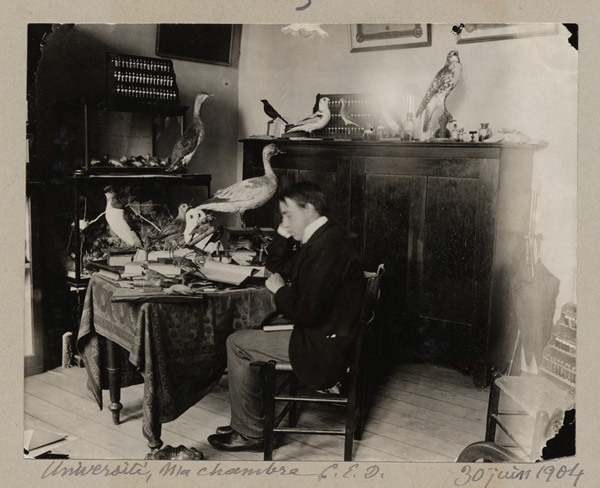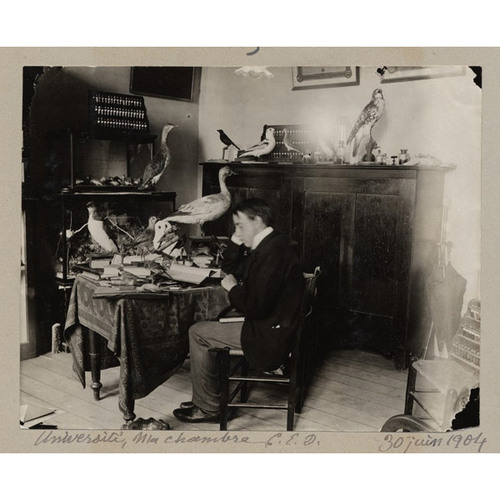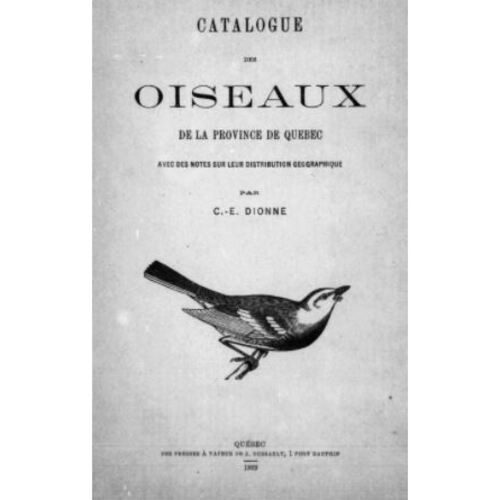
Source: Link
DIONNE, CHARLES-EUSÈBE, taxidermist, museum curator, ornithologist, naturalist, and author; b. 20 July 1846 in Saint-Denis, near Kamouraska, Lower Canada, son of Eusèbe Dionne and Amélie (Émilie) Lavoie; m. 6 May 1879 Marie-Émélie Pelletier at Quebec; they had no children; d. there 25 Jan. 1925 and was buried 28 January in the Saint-Charles cemetery.
Charles-Eusèbe Dionne was the eldest in a hard-working family of 11 children: six boys and five girls. Despite their modest means (Eusèbe was a cobbler and farmer), both parents attached considerable importance to education. As a child, Charles-Eusèbe showed a predilection for nature, especially birds. He did his share of the farm work from an early age, attended local rural schools, and completed elementary schooling at about 14. Eager to learn and endowed with a keen intelligence, he used his free time to increase the knowledge he had acquired at school by reading the few books he could find. He also attended private classes given by a teacher in the village.
In 1865 Dionne went to Quebec; obtaining a routine job (as a handyman) at the Séminaire de Québec, he immediately came to the attention of his employers and in 1866 he was promoted to the position of attendant in the faculty of law at the Université Laval. This post gave him access to the university library and to books on natural history not previously available to him. He was now able to continue his personal education through reading and attending evening classes, with the encouragement of the priests at the seminary. Strongly motivated and possessed of an astonishing capacity for work, Dionne acquired a good knowledge of natural science, English, and Latin. He began studying taxidermy, which he would master within a few years; it would lead him to assemble collections of natural history specimens. From 1867 he took a keen interest in entomology (Abbé Léon Provancher* would recognize Dionne’s competence in 1879 by naming a new species in his honour – tryphon dionnei). By 1887 his entomological collection contained some 1,525 species. Always meticulous, Dionne noted his findings about the anatomy, diet, and economic importance of the animals he mounted or observed, and about plant life. He would later use this material in his publications.
After his humble beginnings at the Séminaire de Québec and several years as assistant librarian, Dionne’s personal and intellectual merits, as well as his store of knowledge, which he kept up to date, were acknowledged by his superiors there. In 1882, on the death of François-Xavier Bélanger*, he was appointed curator of the Musée Zoologique at the Université Laval with an annual salary of $350. As curator, he was instrumental in developing the university’s natural history collections and in displaying the fauna of Quebec to the students and the public by means of mounted specimens. The university would recognize the value of his work by granting him an ma in September 1902 and an honorary doctorate in science a few days before his death.
In 1893 Dionne was made an elective member of the American Ornithologists’ Union, in recognition of his competence as a North American ornithologist. It was mainly through his publications that he had become known to the public and to naturalists in Quebec, the rest of Canada, and the United States. In 1883 he had published at Quebec Les oiseaux du Canada, which had been favourably received in French-speaking circles, although the English-speaking critics had been harsher in their assessment of its worth. His Catalogue des oiseaux de la province de Québec, avec des notes sur leur distribution géographique was brought out at Quebec in 1889. It was a new edition of his first work, with information not relating to Quebec deleted and appropriate data added from the Check-list of North American birds, which had been published in New York by the American Ornithologists’ Union in 1886. Les mammifères de la province de Québec came out at Quebec in 1902 and met with immediate success throughout the province. Here, for the first time, information was available in French about the mammals of Quebec. His major work, Les oiseaux de la province de Québec, was published at Quebec in 1906. This volume of more than 400 pages presented every species of bird that had been recorded in Quebec. One of its great virtues was that, for the first time in Canada, French terminology for the anatomy of birds was given, as well as consistent French names for all the species included. The information it contained combined various observations that Dionne had made with a synthesis of ornithological knowledge either provided by the best writers of the time, among them Elliott Coues and Robert Ridgway, or taken from sources such as the 1895 Check-list of North American birds. The details about the geographical distribution of species in Quebec were based on notes that Dionne had accumulated throughout his career, especially in the Quebec and Saint-Denis regions. He also relied on the works of Napoléon-Alexandre Comeau for the Godbout and Côte-Nord region and of Ernest Douglas Wintle for the Montreal region (The birds of Montreal, published in Montreal in 1896). For a long time Les oiseaux de la province de Québec was the only book dealing exclusively with the birds of the province, and it helped make them better known to the French-speaking community. Dionne also had a number of articles dealing with the distribution of birds in Quebec in prominent scientific journals such as the Auk (the American Ornithologists’ Union) and Le Naturaliste canadien. It was in the latter journal also that his long article on spiders, “Nos araignées: mœurs et description,” appeared in 1910; the result of meticulous observations, it was brought out in pamphlet form at Quebec that same year.
Apart from local excursions, a few visits to Saint-Denis, and an expedition to collect fish in the estuary and Gulf of St Lawrence and the Baie des Chaleurs in 1882, a trip to Trois-Rivières, Montreal, and Ottawa in 1907, a cruise on the Saguenay in 1914, and another trip to Montreal in 1916–17, Dionne travelled little, especially outside the province of Quebec. He did, however, visit the Field Museum of Natural History and the Columbian exposition in Chicago in 1893, as well as the American Museum of Natural History and the zoos at New York in 1911. He spent some weeks in Europe in 1912, travelling around several regions of Italy, Switzerland, France, and England. Among the places he visited in Paris were the Muséum National d’Histoire Naturelle and the Jardin des Plantes. In London he went to the British Museum.
An exceptional self-educated man, Charles-Eusèbe Dionne in a noteworthy way helped make nature, and especially birds, known and appreciated at a time when the daily necessities of life took precedence. Although his immediate influence was mainly confined to the Quebec City region, his works circulated more widely in French-speaking parts of the country for many years.
ANQ-BSLGIM, CE104-S15, 21 juill. 1846. ANQ-Q, CE301-S22, 6 mai 1879. MCQ-FSQ, SME 1/MS-34.6, 16 sept. 1902; MS-34.10, 13 mai 1918; MS-34.11, 25 janv. 1925; Séminaire, 561, no.18; SME, 1er juill. 1873, 19 juin 1877, 7 oct. 1907, 19 janv. 1925. La Presse, 8 sept. 1937. D. A. D. [D.-A. Déry], “In memoriam: Charles Eusebe Dionne, born July 11, 1845, died January 25, 1925,” Canadian Field-Naturalist (Ottawa), 39 (1925): 61–63. “Feu C.-E. Dionne,” Le Naturaliste canadien (Québec), 52 (1925): 171–75. Victor Gaboriault, Charles-Eusèbe Dionne, naturaliste, né à Saint-Denis-de-la-Bouteillerie (La Pocatière, Qué., 1974). H. F. L[ewis], “Dr. Charles Eusebe Dionne,” Auk: a Quarterly Journal of Ornithology (Lancaster, Pa), 42 (1925): 308–9.
Cite This Article
Henri Ouellet, “DIONNE, CHARLES-EUSÈBE,” in Dictionary of Canadian Biography, vol. 15, University of Toronto/Université Laval, 2003–, accessed January 18, 2026, https://www.biographi.ca/en/bio/dionne_charles_eusebe_15E.html.
The citation above shows the format for footnotes and endnotes according to the Chicago manual of style (16th edition). Information to be used in other citation formats:
| Permalink: | https://www.biographi.ca/en/bio/dionne_charles_eusebe_15E.html |
| Author of Article: | Henri Ouellet |
| Title of Article: | DIONNE, CHARLES-EUSÈBE |
| Publication Name: | Dictionary of Canadian Biography, vol. 15 |
| Publisher: | University of Toronto/Université Laval |
| Year of publication: | 2005 |
| Year of revision: | 2005 |
| Access Date: | January 18, 2026 |




